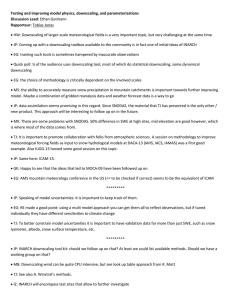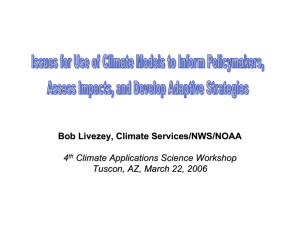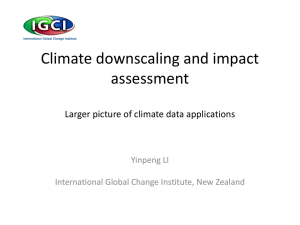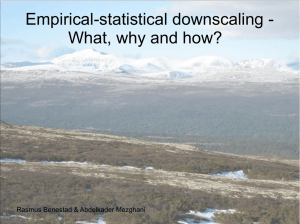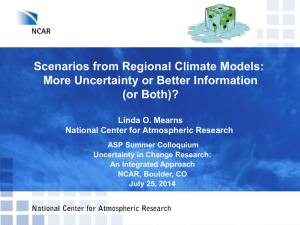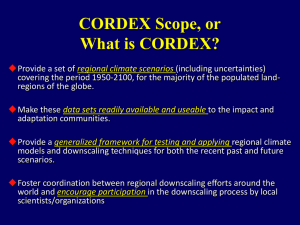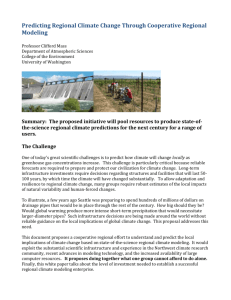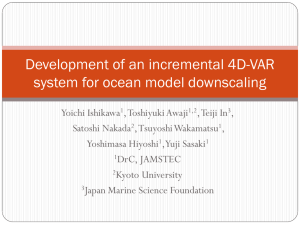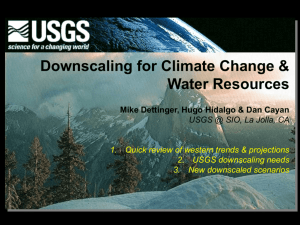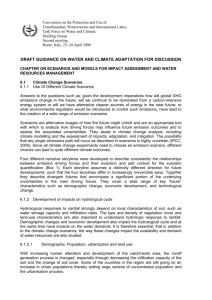Downscaling
advertisement
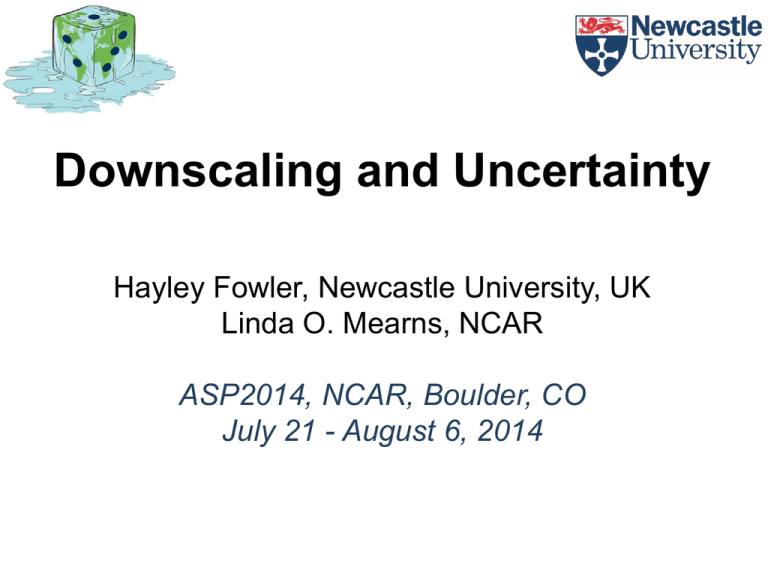
Downscaling and Uncertainty Hayley Fowler, Newcastle University, UK Linda O. Mearns, NCAR ASP2014, NCAR, Boulder, CO July 21 - August 6, 2014 Overview • What is downscaling? • Different methods that are used – advantages/disadvantages • Comparisons • Uncertainties • How (not) to choose a downscaling method? Example applications • UKCP09 weather generator • Towards Climate Services The Uncertainty Cascade or Pyramid Wilby and Dessai (2010) IPCC AR4 WG2 2007 (modified after Jones, 2000, and "cascading pyramid of uncertainties" in Schneider, 1983) Decision-Making (Assessment of needs, decision entry points, institutional constraints, politics etc.) Downscaling There is a gap between climate model resolution and that of local-scale processes. Problematic when assessing the impacts of climate change e.g. hydrology, ecosystems, agriculture. Downscaling refers to a range of techniques that aim to bridge this gap. image courtesy of Dr. Andrew Wood, NOAA/NWS NWRFC Downscaling Types General Circulation Models (GCMs) e.g. HadAM3H, ECHAM4 Statistical / Empirical Downscaling Change Factors Regression methods Dynamical Downscaling Weather/circulation classification Stochastic weather generators Regional Climate Models (RCMs) e.g. HIRHAM, RCAO Downscaled climate outputs Simple downscaling methods: Analogues Analogues make use of observed data – Spatial analogue • Select area with climate similar to that predicted • Simple but inflexible: limited by availability – Temporal analogue • Select time period with desired climate • Simple but inflexible: may not have period with predicted properties Simple downscaling methods: Change Factors (Delta method) • Very widely used • Most commonly used method in UK water industry assessments (up to 2009!) • Take change factor between control and future simulations of climate models (GCM or RCM) and apply to observed climate series (e.g. monthly rainfall totals) • More sophisticated use of change factors is with stochastic methods such as weather generators – more later…. Simple downscaling methods: Bias correction (local scaling) raw model output 1961-1990 observed station data corrected model output raw model output 2071-2100 Simple downscaling methods: Bias correction (QQ correction) Maraun, 2013 Statistical downscaling methods: Transfer functions 12 The UKCP09 Weather Generator Observed rainfall data (+ RCM change factors) NSRP RAINFALL MODEL Multiple Simulated Rainfall Series (1) Primary variable: Precipitation (mm) (2) Secondary variables: Mean temperature (°C) Daily temperature range (°C) Vapour pressure (hPa) Wind speed (ms-1) Sunshine duration (hours) Observed daily weather data (+ RCM temperature change factors) CRU WEATHER GENERATOR Multiple series of simulated weather variables + PET + direct and diffuse radiation 13 Change Factor Perturbation Method Factors are multiplicative (except for mean temperature) Hourly stats derived using observed regression relations (fixed for future) Inter-variable relationships also fixed for future So, no change information included at higher than daily resolution Observed statistics X Mean RCM change factors Mean Proportion Dry Proportion Dry Variance Variance etc. X Statistical downscaling • Advantages • Not computationally intensive • Applicable to GCM and RCM output • Provide station/point values • Disadvantages • • • • • Lack of long/reliable observed series Affected by biases in the GCM/RCM Not physically based e.g. climate feedbacks Under-estimate variability and extremes Assume stationary relationships in time Comparison of downscaling methods • We know theoretical strengths and weaknesses of downscaling methods, where systematic inter-comparisons have been made, e.g. STARDEX, no single best downscaling method is identifiable – temperature can be downscaled with more skill than precipitation – winter climate can be downscaled with more skill than summer due to stronger relationships with large-scale circulation – wetter climates can be downscaled with more skill than drier climates • Direct comparison of skill of different methods difficult due to the range of climate statistics assessed in the literature, the large range of predictors used, and the different ways of assessing model performance Largest uncertainties • Choice of downscaling method • Choice of predictor variables (statistical methods) • Lack of predictability (tropics, convective processes dominate) • Driving GCM boundary conditions (dynamical downscaling), parameterisations, structural assumptions, initial conditions etc. How to choose a downscaling method? Additional comparison studies are not needed • Little consideration given to the most appropriate downscaling method to use for a particular application • Need to define the climatic variables that it is necessary to accurately downscale for each different impact application • Different climates, different seasons and different climatic variables may be more accurately downscaled by using more appropriate downscaling methods Flooding Low 15minute, 2km Hourly, 5km Medium High UKCP09 sample applied to rainfall model and Urban Inundation Model Damaging winds Number of potentially damaging events per year 2 1.6 Baseline 1.2 0.8 0.4 0 ‘Low’ climate projection ‘Central estimate’ climate projection ‘High’ climate projection 20 SDSM-DC 21 Use of SDSM Wilby and Dawson, 2013 22 Towards Climate Services… 23 Towards Climate Services… Central objective: to take the first step towards the realisation of a European Climate Service. • Researchers, in close cooperation with users, develop and demonstrate local climate services to support climate adaption policies. • Provides climate services for several climate-vulnerable regions in Europe, organized at a sectorial level: cities, water resources, coastal defence and energy production. • Will define, in conceptual terms, how a pan-European Climate Service could be developed in the future, based on experiences from local services and the involvement of a broader set of European decision makers and stakeholders.

